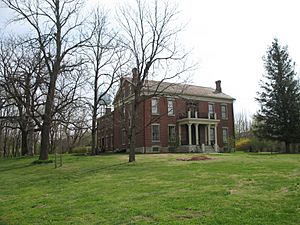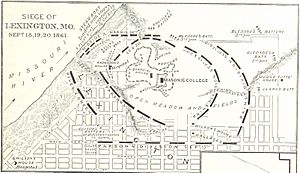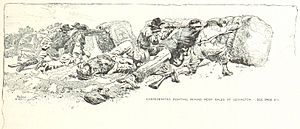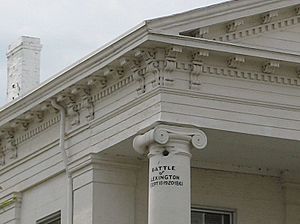First Battle of Lexington facts for kids
Quick facts for kids Siege of Lexington |
|||||||
|---|---|---|---|---|---|---|---|
| Part of the Trans-Mississippi Theater of the American Civil War |
|||||||
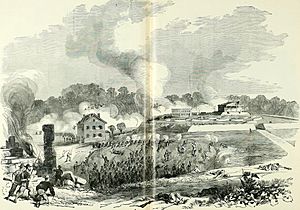 The Siege of Lexington, Mo. by F. B. Wilkie |
|||||||
|
|||||||
| Belligerents | |||||||
| Commanders and leaders | |||||||
| Units involved | |||||||
| Missouri State Guard | 23d Illinois Infantry | ||||||
| Strength | |||||||
| 15,000 | 3,500 | ||||||
| Casualties and losses | |||||||
| ~150 (30 killed, 120 wounded) | ~36 killed, 117 wounded, 8 missing, ~3,000 captured | ||||||
The Siege of Lexington, also known as the First Battle of Lexington, was an important event in the American Civil War. It happened from September 13 to 20, 1861. This battle was fought between the Union Army and the pro-Confederate Missouri State Guard. It took place in Lexington, Missouri, a town in Lafayette County. The Missouri Guard won this battle. Their victory helped strengthen support for the Southern cause in the area. It also gave the Missouri State Guard control of the Missouri River Valley for a short time.
Why the Battle of Lexington Happened
Before the Civil War, Lexington was a busy farming town. It had over 4,000 people and was an important stop on the Missouri River. The town was wealthy because of its trade in hemp (used for ropes), tobacco, coal, and cattle. Even though Missouri stayed with the Union during the war, many people in Lexington owned slaves. They supported the Southern side. About one-third of Lafayette County's population were enslaved people.
Union Soldiers Arrive in Lexington
After the Battle of Boonville in June 1861, Union General Nathaniel Lyon sent soldiers to Lexington. These soldiers were from the 5th Regiment of the United States Reserve Corps. They arrived on July 9 and were led by Colonel Charles G. Stifel. The soldiers set up their headquarters at the old Masonic College in Lexington. They started building defenses and making the area stronger.
Stifel's soldiers also searched for boats that could be used to cross the river. They took or destroyed them. They also found and took gunpowder, muskets, and two cannons. Local groups who supported the Union, called home guard companies, were also formed.
Changes in Command and Early Skirmishes
In mid-August, many of Stifel's soldiers had to leave because their enlistment time was up. Major Frederick W. Becker took command for a short time. Meanwhile, a pro-Confederate leader named Colonel Henry Lewis Routt gathered about a thousand men. Routt had previously taken weapons from the Liberty Arsenal.
Routt's men arrested some important Union supporters. Then, they surrounded the Union outpost in Lexington. Routt demanded that Becker surrender, but Becker refused. One night, Becker's men fired three shells into Routt's camp. This caused a scare but no real damage. When Routt heard that more Union soldiers were coming, he left the area.
Confederate Forces Advance
After winning the Battle of Wilson's Creek in August, the main pro-Confederate Missouri State Guard army marched towards Lexington. They were led by Major General Sterling Price and had about 7,000 men. Price wanted to take control of the Missouri River from the Union. He also wanted to gather more recruits. As he marched, Price's army grew to about 15,000 men.
More Union soldiers arrived in Lexington in early September. These included the 13th Missouri Infantry and a battalion of the United States Reserve Corps. Union General John C. Frémont ordered that money be taken from local banks. This was to prevent the pro-Confederate governor from getting funds. About $1,000,000 was taken from the Farmers' Bank in Lexington.
Colonel Mulligan Takes Command
On September 10, Colonel James A. Mulligan arrived in Lexington. He took command of the Union forces with his 23rd Illinois Volunteer Infantry Regiment, known as the "Irish Brigade." Mulligan now had 3,500 men. He quickly started building strong defenses around the Masonic College. They cut down trees to clear lines of fire and built earth walls. However, they soon faced a serious problem: a shortage of drinking water.
The Battle Begins
First Clashes and Artillery Fire
General Price and his large army arrived at Lexington on September 11, 1861. Fighting started on the morning of September 12. Two Union companies were positioned behind piles of hemp plants on a hill. They fought against Price's cavalry. Price pulled back to wait for his artillery and infantry.
Later that afternoon, Price's forces advanced again. Mulligan sent Union soldiers to stop them. They fought among the tombstones in Machpelah Cemetery, south of town. This gave Mulligan's men more time to finish their defenses. Price's artillery and infantry eventually pushed the Union defenders back to their main fortifications.
Price's cannons then began shelling the Union defenses at the college. Union cannons fired back. The two-and-a-half-hour cannon fight used up a lot of the State Guard's ammunition. Also, many of Price's supplies were left behind. Because of this, Price decided not to attack the strong Union defenses right away. He chose to wait for more supplies and soldiers. "It is unnecessary to kill off the boys here," he said. "Patience will give us what we want." So, he ordered his infantry to move back to the county fairgrounds.
The Attack on the Anderson House
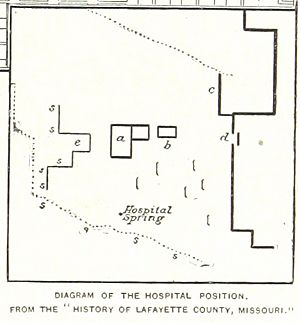
The Anderson House was a large, beautiful home near Colonel Mulligan's defenses. Around July 1861, the Anderson family was asked to leave their home. It was then turned into a Union hospital. Over a hundred sick or wounded Union soldiers were inside when the battle began.
Because of its important location, Confederate General Thomas Alexander Harris ordered his soldiers to capture the house on September 18. Colonel Mulligan was upset, believing this was against the rules of war. He ordered his men to take the house back. Union troops charged and recaptured the house, but many were hurt. Harris's troops took the hospital back later that day. It stayed in Confederate hands for the rest of the battle.
During the fight for the Anderson House, three Confederate soldiers were killed by Union troops. The Confederates said these men had surrendered and should have been taken prisoner. The Union troops, who had suffered many injuries, felt the Confederates had broken the rules of war by attacking a hospital. The Anderson House was badly damaged during the battle. Many holes from cannons and rifles can still be seen there today. The Anderson House and Lexington Battlefield became a historic site in 1969.
Preparing for the Final Attack
On September 19, the Confederate State Guard made their positions stronger. They kept firing cannons at the Union soldiers and got ready for their final attack. A big problem for the Union defenders was a lack of water. Their wells had dried up. Confederate sharpshooters were also watching a nearby spring, shooting at anyone who tried to get water.
Mulligan sent a woman to the spring, hoping she would be safe. Price's troops did not fire and even let her take some water back to the thirsty Union soldiers. However, this small amount of water was not enough to solve the growing thirst among the Union troops. This lack of water played a part in their defeat.
General Price set up his headquarters in a bank building on Main Street. On September 20, a cannonball, likely fired by a Confederate battery, hit the nearby Lafayette County Courthouse. This was only about 100 yards from Price's headquarters. The cannonball is still visible in the courthouse column today.
On the evening of September 19, Confederate soldiers began using large bales of hemp from nearby warehouses. They used these bales to build a movable wall, or breastwork. These bales were soaked in river water overnight. This made them resistant to any hot cannonballs fired by the Union guns. The plan was for the Confederate troops to roll these bales up the hill the next day. They would use them for cover as they moved closer to the Union defenses for a final charge.
The Hemp Bale Attack
Early on the morning of September 20, the Confederate soldiers advanced behind their moving hemp bale walls. As the fighting continued, more Confederate soldiers joined them. This increased the amount of fire directed at the Union troops. The Union defenders fired hot cannonballs at the advancing bales. But because the bales had been soaked in the Missouri River, they did not catch fire.
By early afternoon, the rolling walls had moved close enough for the Confederates to rush the Union defenses. Colonel Mulligan asked for surrender terms after noon. At 2:00 p.m., his men left their trenches and stacked their weapons. The battle was over.
Many years later, Jefferson Davis, the president of the Confederacy, praised the idea of using hemp bales. He called it a "brilliant conception."
What Happened After the Battle
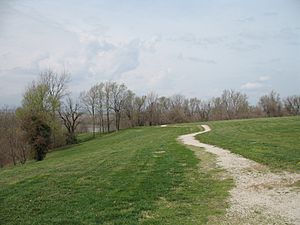
The number of soldiers hurt or killed at Lexington was fairly low. This was because much of the fighting happened from protected positions. Price reported that his side lost about 30 killed and 120 wounded. The Union forces lost 39 killed and 120 wounded. The Union's strong defenses and the Confederates' clever use of hemp bales helped keep casualties down. However, the entire Union army was captured.
The captured Union soldiers had to listen to a speech from the former pro-Confederate Missouri governor, Claiborne Fox Jackson. He criticized them for entering his state and fighting its citizens. General Price then released most of the Union soldiers, making them promise not to fight again. Colonel Mulligan, however, refused to be released. Price was so impressed by Mulligan that he offered him his own horse and buggy. He also ordered Mulligan to be safely taken back to Union lines. Mulligan was later fatally wounded in another battle in 1864. Price continued to lead Confederate forces in many battles.
After the surrender, the Union and Confederate leaders agreed to exchange prisoners. Some of Mulligan's captured soldiers were exchanged for other prisoners. However, some Union enlisted men were sent back to fight without being properly exchanged. Some of these men were later captured again in another battle. They were recognized and executed for breaking their promise not to fight.


